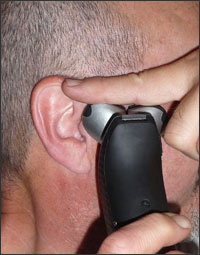Shaving Your Face
Many people consider shaving a personal grooming task that is potentially dangerous for someone who is blind or has low vision. In everyday practice, however, the skill is not dangerous at all. Many skills and techniques involved in shaving do not rely upon vision and may only require basic safety adaptations and closer attention to tactile feedback.
Preparation for Shaving

- Using your sense of touch, you can determine the areas that require shaving (such as your face, legs, or underarms) or the location of a nick or scratch.
- See Maximizing All of Your Senses for information and exercises that help you create a mental picture of your face and shaving area and use your other senses to increase your confidence and safety when shaving.
- If you’ve had sight previously and like to stand in front of a mirror when you shave, you can continue to do so. Many say that using a mirror feels more comfortable and natural, even when it’s difficult to see clearly.
- You can also use a magnifying mirror with an adjustable arm to enlarge the image of your face and head.
- Basic shaving supplies should include a razor, shaving cream or lotion, an after-shave, a washcloth, and a towel.
- Assemble all of your shaving supplies before you begin. You can gather them on a tray, a washcloth, or a hand towel.
- Wash the area to be shaved with soap and water and pat dry. This will soften your hair or whiskers, which makes it easier to shave cleanly and safely.
- Use shaving cream or lotion if you use a safety razor. It will protect your skin and help you locate the areas you’ve already shaved.
Selecting Your Razor
- An electric shaver is an option, but you can continue using a safety razor.
- Some individuals prefer a wet/dry electric razor because it combines the qualities of a safety razor and an electric razor.
- Generally, a safety razor provides a closer shave. Always use a sharp or new blade since dull blades can cause nicks, scratches, and cuts.
- The choice of razor is up to you and should reflect your shaving preferences.
- If you use an electric shaver, follow the manufacturer’s operating instructions and cleaning procedures. You can contact the manufacturer and request braille or large print instructions if they are available.
General Shaving Techniques and Adaptations for Men and Women Who Are Blind or Have Low Vision

- First, take time to feel and explore the contours of your face or the area to be shaved.
- Practice first with an empty razor or with the electric razor turned off.
- Use your hand not holding the razor as a “guide hand” to explore the area you are about to shave.
- The guide hand can also tighten the skin, allowing the hairs to stand up straight for a closer shave.
- You can also use your free hand as a guide for repositioning the razor when you make a new stroke.
Shaving Your Face

- One way to begin is to place the index finger of your guide hand at the base of a sideburn, which can act as a “landmark.” Bring the hand holding the razor up to meet the guide finger. Shave downward at an angle over the cheekbone, from the sideburn line toward the chin.
- As an alternative, use the earpiece of your eyeglasses as a “landmark.”
- For the best coverage, use overlapping strokes and shave the area a second time at a 90-degree angle to the original strokes.
- In areas where your beard is heavier, such as the chin and neck, shave against the grain of the whiskers.
- In areas where the skin is more sensitive, such as the cheeks and upper lip, use downward strokes and shave with the grain of the whiskers.
- Shave one side of your face at a time, which helps you keep track of the areas you’ve shaved.
- Place your fingertip over the area and shave around it to protect moles and skin blemishes.
- When you’re done, use your fingertips to check one more time for unshaven areas.
- Check your ears and the tip of your nose for excess shaving cream.
Trimming or Shaping Your Beard
- Shape your beard or sideburns with a beard trimmer to help maintain a desired contour or straight line.
- Use the hand not holding the trimmer as a guide to explore and precede the area you are about to trim.
- Ask your barber to touch up the outline of your beard or sideburns when you get a haircut and correct any small errors you may have made.
Shaving Your Legs or Underarms
- It’s best to be seated when shaving your legs. A chair also provides orientation and support.
- The tub’s edge is not a safe seat or sturdy location for supporting a leg when standing to shave.
- For the best coverage, use overlapping strokes and shave against the grain of the hair.
- When you’re done, use your fingertips to check one more time for unshaven areas.
- Check the front and back of your knees and around your ankles for excess shaving cream.
Additional Resources for Personal Care
- If you would like additional instruction in shaving techniques or other areas of personal self-care, you can contact a Vision Rehabilitation Therapist. See Vision Rehabilitation Services on this website for more information.
By Maureen A. Duffy, M.S., CVRT